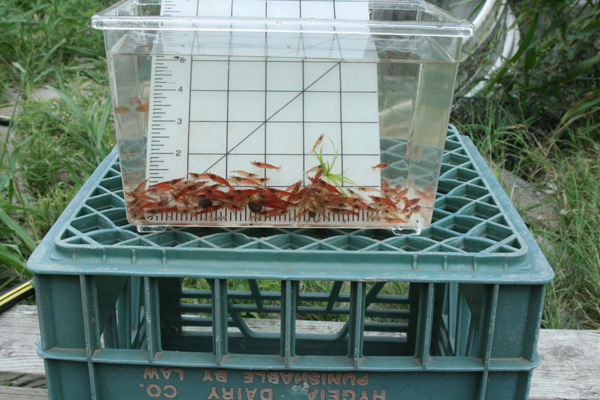This pretty little shrimp makes a great nano-tank or plant tank specimen. They are not shy and their bright coloration makes them stand out. While they are considered algae eaters, I’ve found they don’t. They sit on the algae and eat bits of food adhering to the plant, but they do not eat algae.
We got our start of red cherry shrimp when I bought a half dozen at what my wife Susie thought was an exorbitant price. I tossed them into a 55 gallon and assumed I’d never see them again. Wrong! Soon the vat was teeming with shrimp. Today, we polyculture them with livebearers, but avoid putting them in breeding tanks since at high populations they will devour newly born fry. I learned that the hard way and lost a couple of breeding cycles of livebearers, especially those with small fry.
We’re working on a blue and an orange color morph. We bought some blue velvets, but only got males, so we’re selecting for blues from our own shrimp.
The photo shows some of the shrimp with an inch grid to show the size of the adults.


Dana says
Hi there. I was interested in a comment you made about “only getting males”. I’ve had red cherry shrimp for about 3 months and had two clutches of eggs hatch successfully.
I’m a bit concerned that there aren’t any females among all the babies. I was wondering if a clutch tends to be all one sex (to prohibit inbreeding; some lizards are like that and it’s temperature dependant) or if there should be males and females from the same clutch. Do you know?
Thanks for the information! I hope the blue morphs work; that would be amazing!
Dana
charles says
We bought 8 of the blue shrimp and all turned out to be males. I don’t know if that was because they were selected to be males or just by chance. We seem to yield a 1:1 sex ratio, but we don’t raise single clutches, so I don’t know if some clutches are all one sex or the other. I don’t think the sex ratio is temperature dependent since we get about a 1:1 sex ratio in the winter (temperatures around 73°F) and in the summer (around 88°F). We raise our shrimp by stocking about 30 shrimp of both sexes in a vat with livebearers. We harvest the shrimp with the fish in about 2.5 months.